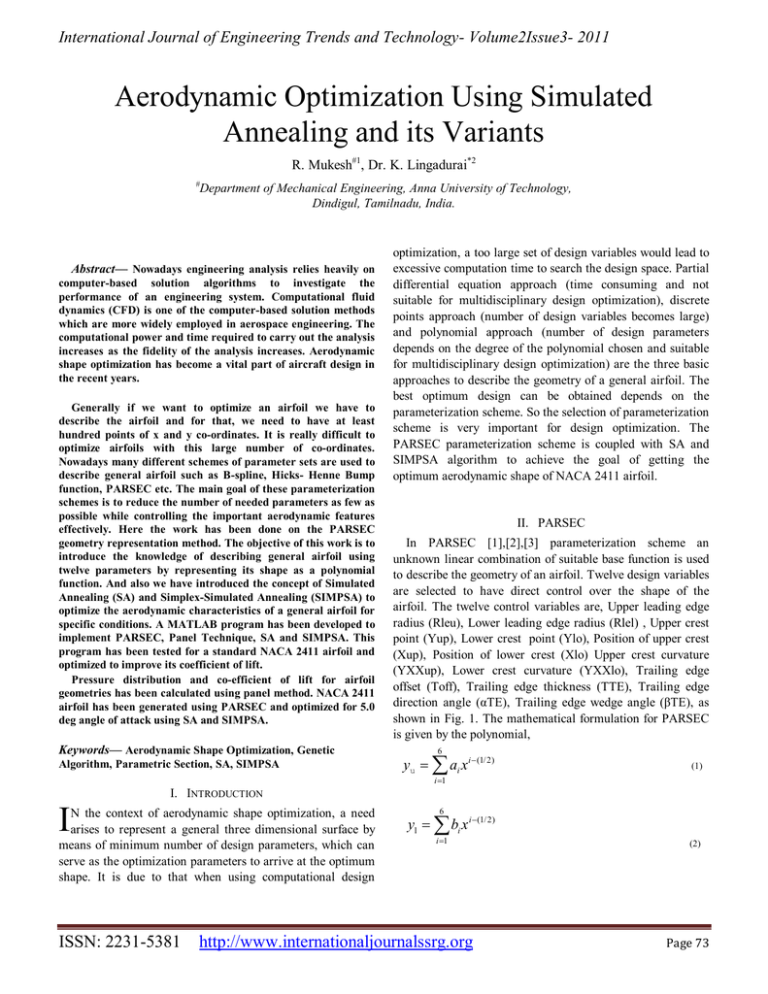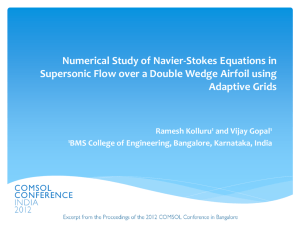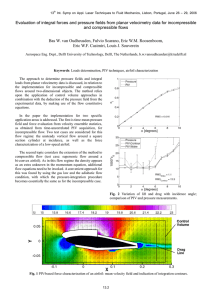Aerodynamic Optimization Using Simulated Annealing and its Variants
advertisement

International Journal of Engineering Trends and Technology- Volume2Issue3- 2011 Aerodynamic Optimization Using Simulated Annealing and its Variants R. Mukesh#1, Dr. K. Lingadurai*2 # Department of Mechanical Engineering, Anna University of Technology, Dindigul, Tamilnadu, India. Abstract— Nowadays engineering analysis relies heavily on computer-based solution algorithms to investigate the performance of an engineering system. Computational fluid dynamics (CFD) is one of the computer-based solution methods which are more widely employed in aerospace engineering. The computational power and time required to carry out the analysis increases as the fidelity of the analysis increases. Aerodynamic shape optimization has become a vital part of aircraft design in the recent years. Generally if we want to optimize an airfoil we have to describe the airfoil and for that, we need to have at least hundred points of x and y co-ordinates. It is really difficult to optimize airfoils with this large number of co-ordinates. Nowadays many different schemes of parameter sets are used to describe general airfoil such as B-spline, Hicks- Henne Bump function, PARSEC etc. The main goal of these parameterization schemes is to reduce the number of needed parameters as few as possible while controlling the important aerodynamic features effectively. Here the work has been done on the PARSEC geometry representation method. The objective of this work is to introduce the knowledge of describing general airfoil using twelve parameters by representing its shape as a polynomial function. And also we have introduced the concept of Simulated Annealing (SA) and Simplex-Simulated Annealing (SIMPSA) to optimize the aerodynamic characteristics of a general airfoil for specific conditions. A MATLAB program has been developed to implement PARSEC, Panel Technique, SA and SIMPSA. This program has been tested for a standard NACA 2411 airfoil and optimized to improve its coefficient of lift. Pressure distribution and co-efficient of lift for airfoil geometries has been calculated using panel method. NACA 2411 airfoil has been generated using PARSEC and optimized for 5.0 deg angle of attack using SA and SIMPSA. Keywords— Aerodynamic Shape Optimization, Genetic Algorithm, Parametric Section, SA, SIMPSA optimization, a too large set of design variables would lead to excessive computation time to search the design space. Partial differential equation approach (time consuming and not suitable for multidisciplinary design optimization), discrete points approach (number of design variables becomes large) and polynomial approach (number of design parameters depends on the degree of the polynomial chosen and suitable for multidisciplinary design optimization) are the three basic approaches to describe the geometry of a general airfoil. The best optimum design can be obtained depends on the parameterization scheme. So the selection of parameterization scheme is very important for design optimization. The PARSEC parameterization scheme is coupled with SA and SIMPSA algorithm to achieve the goal of getting the optimum aerodynamic shape of NACA 2411 airfoil. II. PARSEC In PARSEC [1],[2],[3] parameterization scheme an unknown linear combination of suitable base function is used to describe the geometry of an airfoil. Twelve design variables are selected to have direct control over the shape of the airfoil. The twelve control variables are, Upper leading edge radius (Rleu), Lower leading edge radius (Rlel) , Upper crest point (Yup), Lower crest point (Ylo), Position of upper crest (Xup), Position of lower crest (Xlo) Upper crest curvature (YXXup), Lower crest curvature (YXXlo), Trailing edge offset (Toff), Trailing edge thickness (TTE), Trailing edge direction angle (αTE), Trailing edge wedge angle (βTE), as shown in Fig. 1. The mathematical formulation for PARSEC is given by the polynomial, 6 yu ai xi (1/ 2) (1) i 1 I. INTRODUCTION I N the context of aerodynamic shape optimization, a need arises to represent a general three dimensional surface by means of minimum number of design parameters, which can serve as the optimization parameters to arrive at the optimum shape. It is due to that when using computational design ISSN: 2231-5381 6 yl bi x i (1/ 2) i 1 http://www.internationaljournalssrg.org (2) Page 73 International Journal of Engineering Trends and Technology- Volume2Issue3- 2011 for upper and lower surface respectively. Where yu is the required y coordinate for the upper surface, yl is the required y coordinate for the lower surface and ai, bi are the coefficients to be solved from the twelve control variables. III. SIMULATED ANNEALING Simulated Annealing [6],[7],[8] is one kind of NonTraditional based Optimization algorithm for searching global optimum. It is a point by point method. It resembles the cooling process of molten metals through annealing and the formation of the crystal depends upon the cooling rate. The process of slow cooling is called as annealing. The cooling phenomenon is simulated by controlling a temperature like parameter and it can be done by introducing the concept of Boltzmann probability distribution. In addition to that Metropolis suggested one idea to implement the Boltzmann probability function in simulated systems for better optimization. Figure 1. Control variables for PARSEC The main steps of Simulated Annealing are given as follows: III. PANEL TECHNIQUE a) Choose an Initial Point and a high temperature T. The solution procedure for panel technique consists of discretizing the surface of the airfoil into straight line segments or panels, assuming the source strength is constant over each panel but has a different value for each panel and the vortex strength is constant and equal over each panel [3],[4],[5]. The compressibility and the viscosity of air in the flow field is neglected, and the net effect of viscosity on a wing is summarized by requiring that the flow leave the sharp trailing edge of the wing smoothly. The curl of the velocity field is assumed to be zero. (3) δ where ϕ is the total potential function and its three components are the potentials corresponding to the free stream, the source distribution, and the vortex distribution. These last two distributions have potentially locally varying strengths. Fig. 2 illustrates the nomenclature of an airfoil and the definition of nodes and panels for panel methods respectively. b) A second point is created at random in the vicinity of the initial point. c) The difference between these two points is calculated. d) If the second point has a larger function value, the point is accepted. e) In the next generation, another point is created at random in the neighbourhood of the current point and the Metropolis algorithm is used to accept or reject the point. f) The algorithm is terminated when an optimized value is obtained. The Initial temperature and the number of iterations are the two important parameters of the Simulated Annealing. So we have to choose these two parameters according to our optimization problem to be solved. IV. SIMPSA Figure 2. Nodes and Panels The numbering system starts at the lower surface trailing edge and proceeds forward, around the leading surface and aft to the upper surface trailing edge. N+1 points define N panels. The flow tangency boundary condition is imposed on the points located at the midpoint of each of the panels. Once we found the tangential velocity (Vti) at the midpoint of each panel, then we can compute the pressure coefficient at the midpoint of each panel according to the following formula, Cp ( xi , yi ) 1 [Vti2 /V2 ] ISSN: 2231-5381 (4) SIMPSA [7], [8] is based on the combination of the nonlinear simplex and simulated annealing algorithms. The simplex optimization algorithm uses the expansion and contraction of a simplex generated by different parameter sets to make appropriate moves. Simulated annealing Optimization algorithm employ a stochastic generation of solution vectors and employ similarities between the physical process of annealing i.e. melting a solid by heating it, followed by slow cooling and crystallization into a minimum free energy state. During the cooling process, transitions are accepted to occur from a low to a high energy level through a Boltzmann probability distribution. A recently proposed continuous non-linear solver (SIMPSA) is used to update the continuous parameters, and the Metropolis algorithm is used to update the complete solution vector of decision variables. The SIMPSA algorithm was developed for the global solution of optimization problems. It combines the original Metropolis http://www.internationaljournalssrg.org Page 74 International Journal of Engineering Trends and Technology- Volume2Issue3- 2011 algorithm with the non-linear simplex algorithm. This algorithm shows good robustness and accuracy in arriving at the global optimum of difficult non-convex highly constrained functions V. OPTIMIZATION OF NACA 2411 AIRFOIL The design conditions, optimization constraints are tabulated in Table I. objectives and Table I. Optimization objectives and constraints Angle of attack 5.0 deg Flow constraint Subsonic and incompressible Max thickness must be less than 10% chord length Geometric constraint TTE and Toff the airfoil is Aerodynamic constraint Objective Figure 3. Original NACA 2411 airfoil Vs Optimized Airfoils zero Lift not less than original one Maximize coefficient of lift VI. RESULTS The initial PARSEC parameters have been given approximately by specifying its lower and upper bound values. There is no need for specifying this accurately. The geometry of the airfoil expressed by the best twelve PARSEC parameters resulting from the SA and SIMPSA algorithm exhibits a considerable increase in the coefficient of lift. The comparison between the original NACA 2411 airfoil and the optimized airfoils are indicated in Fig. 3 and Fig. 4. The comparison of pressure distribution over the surface of the original NACA 2411 airfoil and the optimized airfoils are shown in Fig. 5 and Fig. 6. Their corresponding PARSEC parameters and coefficient of lift are tabulated in Table II and Table III respectively. Figure 4. Optimized SA Airfoil Vs Optimized SIMPSA Airfoil ISSN: 2231-5381 http://www.internationaljournalssrg.org Page 75 International Journal of Engineering Trends and Technology- Volume2Issue3- 2011 Table II. Optimized PARSEC parameters Figure 5. Comparison of pressure distribution over the surface of Optimized Airfoils Parameter Value original Value optimize dUsing SA Value optimized Using SIMPSA (Rleu) 0.0216 0.0217 0.02 (Rlel) 0.008 0.0099 0.0098015 (Xup) 0.3445 0.3129 0.3 (Yup) 0.07912 0.0787 0.079855 (YXXup) -0.6448 -0.6370 -0.63221 (Xlo) 0.17 0.1784 0.17941 (Ylo) -0.03379 -0.0328 -0.032341 (YXXlo) 0.6748 0.6761 0.67897 (TTE) 0 0 0 (Toff) 0 0 0 (αTE) -4.785 -4.7852 -4.8 (βTE) 15.082 15.0715 15.062 Table III Original vs. Optimized Coefficient of Lift Angle of attack Cloriginal 5.0 0.8420 Cloptimized Cloptimized Using SA Using SIMPSA 1.0336 1.0729 Figure 6. Comparison of pressure distribution over the surface of NACA 2411 and Optimized SIMPSA Airfoil ISSN: 2231-5381 http://www.internationaljournalssrg.org Page 76 International Journal of Engineering Trends and Technology- Volume2Issue3- 2011 potential application of this process is that it acts as a datamining process to increase design knowledge. VII. CONCLUSION The geometry of NACA 2411 airfoil is optimized to improve its coefficient of lift for 5.0 deg angle of attack. The optimized airfoils have the improved coefficient of lift of 1.0336 and 1.0729 as compared to the original one which had 0.8420. The PARSEC parameterization scheme is used to express the shape of the airfoil. The result shows that the PARSEC parameters show good correlation between design parameters and aerodynamic performance. The impact of individual PARSEC parameters on the aerodynamic properties of the airfoil can be predicted more easily. There is no need for baseline shape and typical geometric constrains on the airfoil shape can be expressed or approximated by simple bound or linear constrains. The panel method gives reasonable accuracy in predicting the pressure distribution over the surface of the NACA 2411 airfoil for low speed, incompressible subsonic flows. SA and SIMPSA algorithms are so effective in finding the best solution among many possible solutions within a search space. During this problem of optimization plenty of design data are obtained. It is possible to create a model from these design data. The ISSN: 2231-5381 REFERENCES [1] [2] [3] [4] [5] [6] [7] [8] R. Balu and U. Selvakumar, “Optimum hierarchical Bezier parameterization of arbitrary curves and surfaces,” 11th Annual CFD Symposium, Indian Institute of Science, Bangalore, India, pp. 46-48, Helmut Sobieczky, “Parametric airfoils and wings”, Notes on Numerical Fluid Mechanics, Volume 68 Vieweg verlag, pp. 71-88, 1998. P.R. Mukesh, U.Selvakumar, “ Aerodynamic Shape Optimization using Computer Mapping of Natural Evolution Process”, In: Proceedings of the 2010 International Conference on Mechanical and Aerospace Engineering at University of Electronics Science and Technology of China, China, April 16-18, 2010.Volume 5, pp 367 - 371 J.L. Hess, “Panel methods in computational fluid mechanics”, Annual Review of Fluid Mechanics, Vol.22, pp. 255-274, 1990. J. Katz and A. Plotkin, “Low-speed aerodynamics from wing theory to panel methods”, McGraw-Hill, Inc., New York, 1991. Kalyanmoy Deb “Optimization for Engineering Design” PHI, New Delhi, 2010. B. Behzadi, C. Ghotbi and A. Galindo, “Application of the simplex simulated annealing technique to nonlinear parameter optimization for the SAFT-VR equation of state” Chemical Engineering Science, 2005. Margarida, F. Cardoso, R. L. Salcedo and S. Feyo De Azevedo, “ The Simplex-Simulated Annealing to continuous Non Linear optimization” Computers Chemical Engineering, Vol 20, Elsevier 1996. http://www.internationaljournalssrg.org Page 77



